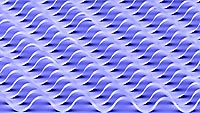 |
Argonne Now |
News updateFlexible electronics could find applications as sensors and artificial musclesFlexible electronic structures that can bend, expand and manipulate electronic devices are being developed by scientists at Argonne National Laboratory and the University of Illinois, Urbana-Champaign. These flexible structures could find useful applications as sensors and as electronic devices that can be integrated into artificial muscles or biological tissues. Current work focuses on developing stretchable electronics and sensors for smart surgical gloves and hemispherical electronic eye imagers. Flexible electronics are important for energy technology as flexible and accurate hydrogen sensors. The underlying concept focuses on forming single-crystalline semiconductor nanoribbons in stretchable geometrical configurations with emphasis on the materials and surface chemistries used in their fabrication and the mechanics of their response to applied strains. This research was conducted at the Center for Nanoscale Materials at Argonne and was funded by the U.S. Department of Energy's Office of Basic Energy Sciences. More... New catalyst helps eliminate NOx from diesel exhaustA catalyst developed by Argonne researchers could help the nation reduce harmful nitrogen oxides from the atmosphere by enabling manu facturers to eliminate these emissions from diesel truck exhausts. Collectively called NOx, they contribute to smog, acid rain and global warming. Argonne's patented technology appears so promising that many large and small companies have expressed interest in licensing it and working with Argonne researchers to scale up the technology and bring it to market. Argonne researcher Christopher Marshall, one of the technology's developers, believes a product using the technology could be commercially available within two to three years. Marshall says the Argonne catalyst has performed well in tests with a number of diesel and diesel-type fuels, including standard diesel, synthetic diesel, bio-diesel and JP8, which is a jet fuel preferred by the military. The next step is to subject the catalyst to engine testing at Argonne's Diesel Engine Test Facility. Marshall expects these tests will show that in addition to its other advantages, the Argonne catalyst has a greater life expectancy than other catalysts currently on the market. More... Argonne and Air Force Research Lab to collaborate on defense technologies and researchArgonne and the Air Force Research Laboratory (AFRL) have signed an agreement that promises to speed the delivery of technological advances to U.S. military forces while saving taxpayer dollars. The agreement promotes cooperative exchange of technical requirements and scientific and technological information between the two laboratories. Officials expect the agreement to improve the cost, schedule and performance goals associated with developing critical technologies for the nation. “Argonne and AFRL will be able to access each other's technologies and capabilities to meet our nation's needs,” said Sandra Biedron, director of Argonne's Department of Defense Project Office. AFRL scientists intend to use Argonne's world-class research facilities, such as the Advanced Photon Source, the Intense Pulsed Neutron Source, the Electron Microscopy Center and the Center for Nanoscale Materials. The AFRL will include Argonne researchers in its Integrated Product Teams and other working groups as appropriate. More... For more information, please contact Dave Baurac (630/252-5584 or media@anl.gov) at Argonne. |
|
||||||
|
||||


